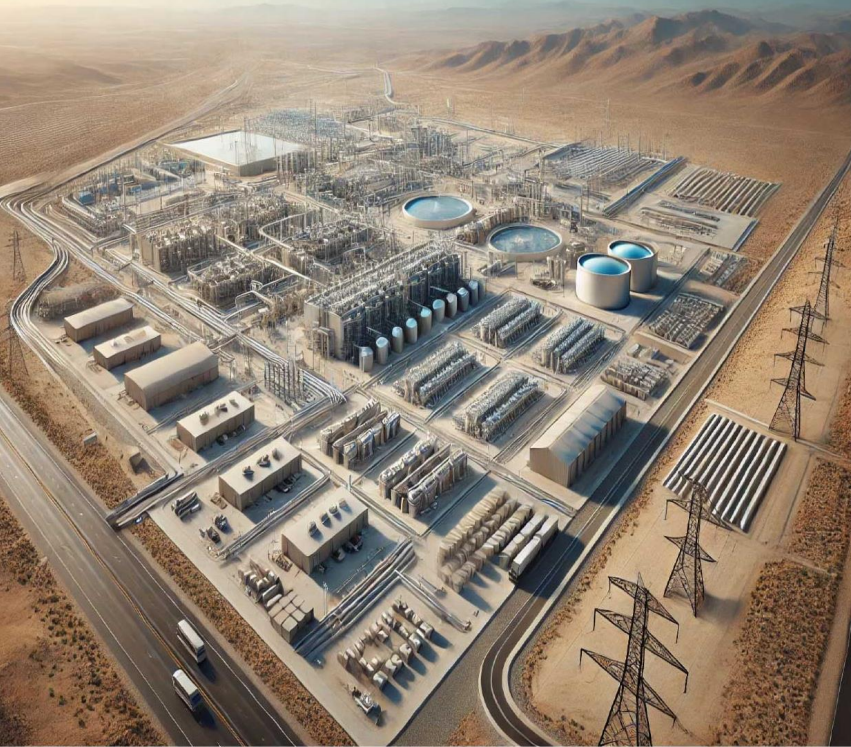OpenAI and Oracle are partnering to build the $165 billion Project Jupiter data center in Santa Teresa, New Mexico, near El Paso as part of OpenAI’s massive Stargate Project – aiming to spend half a trillion dollars this decade on infrastructure that enables artificial intelligence technology.
OpenAI’s announcement this week confirmed the two technology giants are behind the massive project, which was initially proposed by lesser-known BorderPlex Digital Assets out of Austin and its development partner Stack Infrastructure, which is based in Colorado.
“AI can only fulfill its promise if we build the compute to power it,” Sam Altman, OpenAI’s chief executive, said in a statement. Compute refers to the hardware and software needed to run artificial intelligence models.
“That compute is the key to ensuring everyone can benefit from AI and to unlocking future breakthroughs. We’re already making historic progress toward that goal through Stargate and moving quickly not just to meet its initial commitment, but to lay the foundation for what comes next,” Altman said.
President Donald Trump announced the Stargate joint investment initiative in January on his first day in office alongside Altman, Oracle co-founder Larry Ellison and SoftBank Chairman Masayoshi Son. Hours after that announcement, Trump’s then-adviser Elon Musk suggested OpenAI and SoftBank didn’t have the money to accomplish Stargate.
The Doña Ana County Board of Commissioners approved an incentive deal for Project Jupiter by a 4-1 vote last week. That was the last hurdle before the project could proceed.
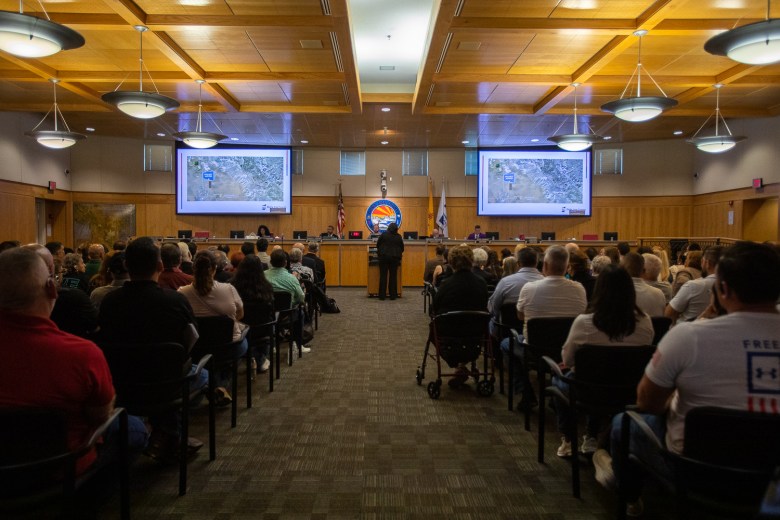 Hundreds of Doña Ana County residents appear at county commissioners’ meeting with a vote on the proposed Project Jupiter data center on the agenda, Sept. 19, 2025. (Corrie Boudreaux/El Paso Matters)
Hundreds of Doña Ana County residents appear at county commissioners’ meeting with a vote on the proposed Project Jupiter data center on the agenda, Sept. 19, 2025. (Corrie Boudreaux/El Paso Matters)
The incoming data center campus in Doña Ana County is one of five sites where OpenAI said it’s building Stargate data centers. Other sites are located in Shackelford County, Texas, near Abilene, and an undisclosed site in the Midwest. OpenAI and the investment firm SoftBank are separately developing two other data centers in Ohio and in Milam County, Texas, near Austin.
“Together with Oracle, SoftBank, and our other partners,” OpenAI said, “we’re turning a $500 billion, 10-gigawatt commitment into large-scale physical infrastructure, jobs in communities across the country, and compute that will unlock the next generation of AI breakthroughs.”
Oracle will lease the AI-training data centers from BorderPlex Digital, and OpenAI will be the facility’s ultimate customer.
OpenAI and Oracle didn’t respond to requests for comment.
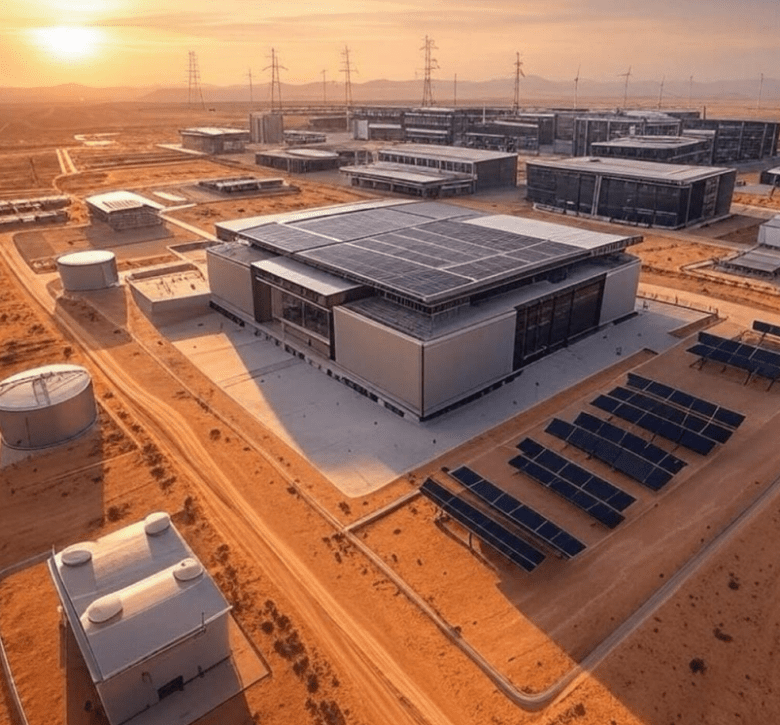 BorderPlex Digital Assets included this rendering of Project Jupiter in a presentation to a legislative committee in New Mexico in July. (BorderPlex Digital Assets)
BorderPlex Digital Assets included this rendering of Project Jupiter in a presentation to a legislative committee in New Mexico in July. (BorderPlex Digital Assets)
The five sites picked to host Stargate data center facilities – including Santa Teresa – were “chosen through a rigorous nationwide process launched in January,” OpenAI said in the statement it issued this week. “OpenAI, Oracle, and SoftBank reviewed over 300 proposals from more than 30 states.”
Project Jupiter will be a collection of four data centers meant for artificial intelligence training, and it would be among the biggest private investments ever made that could reshape the regional economy around El Paso and Las Cruces.
In Santa Teresa, Project Jupiter’s developers plan to invest $50 billion over the next five years, and the companies will invest up to $165 billion over the 30 years. The deal between the developers and Doña Ana County requires the project to employ 2,500 construction workers and then 750 full-time workers once the facility is operational.
The majority of the $165 billion investment will go toward paying for computer equipment such as graphics processing units. And that investment cost factors in three refreshes of the computer equipment every five to seven years, according to Nicholas Minor, director of public affairs for Stack.
In exchange for not having to pay property taxes on the 1,400-acre campus or gross receipts taxes, BorderPlex Digital said it will pay the county $360 million over 30 years – $12 million annually.
Stack also made a binding commitment to give the county $50 million to fund badly needed water and wastewater infrastructure upgrades throughout Doña Ana County. That’s significant because of the legacy of poor drinking water in Sunland Park and Santa Teresa, and the potential impact that funding could have to improve water and sewer systems.
Stack will also give $6.9 million for various community investments in the county, such as new Boys and Girls Club facilities.
Project Jupiter’s water, electricity usage
The data center campus in Santa Teresa will feature a “closed-loop” system of pipes to cool the computer servers inside the data center buildings, which developers say would require a one-time fill-up before the water is recycled over and over.
Filling up the four data centers would require about 10 million gallons of water over two years.
Once it’s operating, the project would use a daily average of 20,000 gallons, with a maximum consumption capped at 60,000 gallons in a day, according to figures provided by the developers.
The Camino Real Regional Utility Authority will supply drinking water for the campus’ “ongoing operations” according to documents that detail the agreement between Doña Ana County and Project Jupiter’s developers.
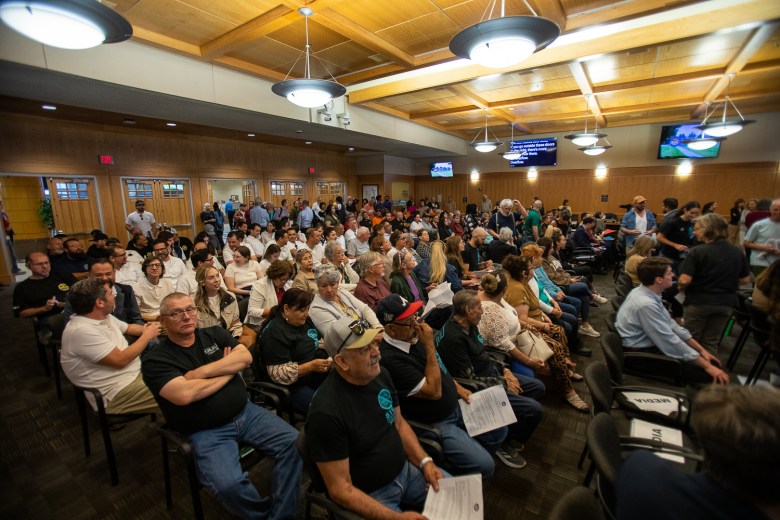 Hundreds of Doña Ana County residents appear at county commissioners’ meeting with a vote on the proposed Project Jupiter data center on the agenda, Sept. 19, 2025. (Corrie Boudreaux/El Paso Matters)
Hundreds of Doña Ana County residents appear at county commissioners’ meeting with a vote on the proposed Project Jupiter data center on the agenda, Sept. 19, 2025. (Corrie Boudreaux/El Paso Matters)
CRRUA, the New Mexico water utility that serves Sunland Park and Santa Teresa, said it produced an average of 2.6 million gallons of water daily from its wells in March.
Earlier this year, Sunland Park announced it would develop its own municipal water utility while Doña Ana County officials said they would take over CRRUA’s assets outside of Sunland Park and create a new water provider for the area.
It’s not clear how splitting CRRUA will impact Project Jupiter, but since the project is located outside of Sunland Park, the new entity the county is setting up will likely take over as the campus’ water provider.
In order to power the campus, the project’s developers said they’ll build a microgrid that will not connect to El Paso Electric’s broader electricity grid.
Project Jupiter’s microgrid will rely on simple-cycle natural gas-fired turbines with a capacity between 700 and 900 megawatts to generate electricity. That’s enough to power several hundred thousand homes, depending on the temperature and time of day.
Simple-cycle natural gas turbines typically use far less water than the water-intensive combined-cycle gas turbines El Paso Electric relies on. Napier said the gas-fired generation facility will use around the same amount of water every day – 20,000 gallons – as the data centers.
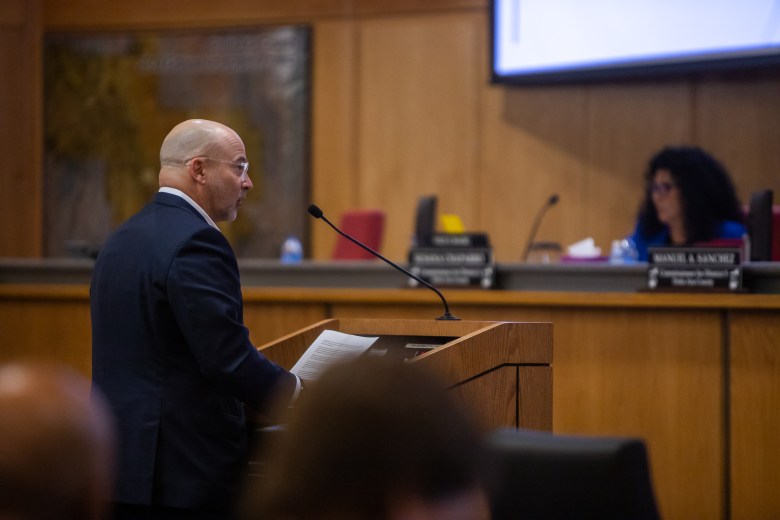 Lanham Napier, chairman of BorderPlex Digital Assets, lists proposed data center Project Jupiter’s promises to contribute to county funds and water management during a Doña Ana County Commissioners meeting, Sept. 19, 2025. (Corrie Boudreaux/El Paso Matters)
Lanham Napier, chairman of BorderPlex Digital Assets, lists proposed data center Project Jupiter’s promises to contribute to county funds and water management during a Doña Ana County Commissioners meeting, Sept. 19, 2025. (Corrie Boudreaux/El Paso Matters)
“Water use for the microgrid is similar to the water use for data center,” Napier told Doña Ana county commissioners.
A rough, back-of-the-envelope estimate would suggest a 700 megawatt natural gas power plant that uses an average of 20,000 gallons of water per day would consume about 1.2 gallons of water per megawatt-hour of electricity generated.
By comparison, El Paso Electric as a whole consumed 478 gallons of water per megawatt-hour of electricity produced last year. The utility is El Paso Water’s biggest customer and bought an average of about 19 million gallons of water per day last year from the city-owned water provider, according to El Paso Water.
Representatives for BorderPlex Digital have also said the data center campus will feature one of the world’s largest battery storage projects so that, by 2045, the facilities can rely entirely on clean energy likely sourced from solar panels and stored in the batteries for use when the sun isn’t shining.
But the companies behind Project Jupiter have some time to get there. The New Mexico Legislature passed a bill earlier this year that allows for the creation of microgrids separate from the main grid that serves most homes and businesses.
The bill – House Bill 93 – includes a carve-out introduced by State Sen. Michael Padilla that allows microgrid operators to skirt the state’s Energy Transition Act.
That law requires the big electric utilities in New Mexico to ensure half of the electricity they sell to customers comes from renewable, zero-carbon energy sources by 2035, and they have to reach 100% clean energy sales by 2045. As of this year, 40% of the electricity New Mexico utilities sell to customers has to come from zero-carbon sources.
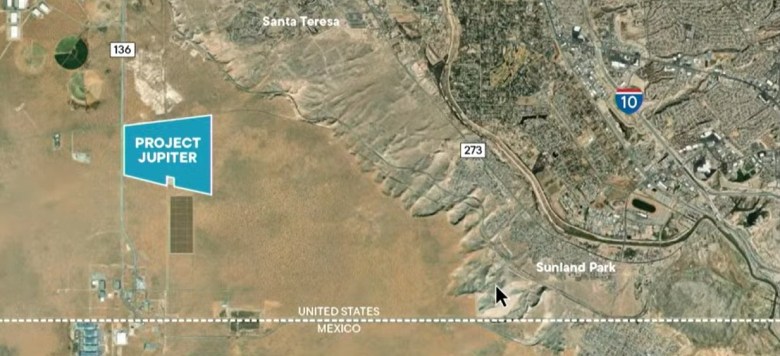 A map shows where the $165 billion data center campus — dubbed “Project Jupiter” would be located in Santa Teresa, New Mexico. (Doña Ana County Board of Commissioners)
A map shows where the $165 billion data center campus — dubbed “Project Jupiter” would be located in Santa Teresa, New Mexico. (Doña Ana County Board of Commissioners)
By 2045, microgrids have to produce 100% carbon-free carbon energy.
Another legislator, District 33 state Rep. Micaela Lara Cadena, who represents Mesilla, called the passage of the amendment that enables Project Jupiter’s microgrid the result of “dirty backroom dealing in Santa Fe.”
“Doña Ana deserved to know about this for more than a month,” Lara Cadena told county commissioners during the meeting in Las Cruces.
“The enabling mechanisms that allow for microgrids, those were not debated in our House,” she said. “They were a last hour amendment – March 20 of a 60-day session – less than 48 hours left, when a shady ass floor amendment was made by Senator Padilla.”
When District 4 County Commissioner Susana Chaparro was the only commissioner to vote against Project Jupiter, she argued state officials and the developers negotiated at the state capitol rather than with locals in Doña Ana County.
“All of these things were done in Santa Fe months before we became aware of it: negotiations, deals, money promised,” Chaparro said before the commissioners’ final vote Sept. 19.
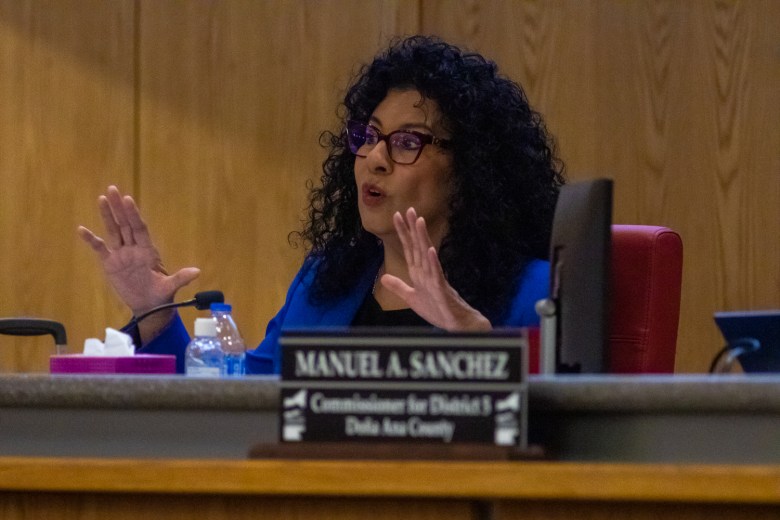 Doña Ana County Commissioner Vice Chair Susana Chaparro motions to table the vote on the proposed Project Jupiter data center for 60 days, Sept. 19, 2025. The motion failed when no other commissioner seconded it. (Corrie Boudreaux/El Paso Matters)
Doña Ana County Commissioner Vice Chair Susana Chaparro motions to table the vote on the proposed Project Jupiter data center for 60 days, Sept. 19, 2025. The motion failed when no other commissioner seconded it. (Corrie Boudreaux/El Paso Matters)
In an interview with El Paso Matters, Padilla pointed out that New Mexico Gov. Michelle Lujan Grisham announced in February that the project would come to Doña Ana County, although she shared few details about Project Jupiter at the time.
Padilla, who has represented a portion of Bernalillo County since 2013, said he pushed the microgrid-related legislation as its own bill but it failed to pass. So, he included the microgrid-related amendment into a bill at the end of the session to ensure it would become law.
“We worked this bill pretty much the entire session, but it did not quite get done. So, we found a piece of legislation that was very similar,” Padilla said. “That’s the legislative process. You have to be very creative to get your work done.”
Padilla, who said he respects Rep. Lara Cadena, added that the law enabled Project Jupiter, which he called “phenomenal” and said the microgrid legislation would also attract other employers to New Mexico in the future.
“If you want to stand up a project like Jupiter, you should also be able to demonstrate that you can generate the power needed for Project Jupiter. So, this particular piece of legislation makes that permissible now,” Padilla told a crowd gathered at a standing-room-only public meeting BorderPlex Digital held Sept. 9 in Sunland Park to share details about Project Jupiter.
“Whereas before, you had to jump through any number of hoops – on fire – and you had to wait around for any number of months or years to get your project approved,” Padilla said. Project Jupiter’s developers are “going to be able to bring the power that they need for their project so it does not affect the local community at all,” he added.
Community involvement
In addition to hosting five community meetings throughout Doña Ana County between Aug. 26 and Sept. 19, Napier said his group conducted outreach by calling 120,000 residents in Doña Ana County for “one-on-one conversations.” He said 83% of residents who answered supported Project Jupiter, but didn’t provide details on the methodology, raising questions from area residents. The county has a population of 229,000 residents, according to the U.S. Census Bureau.
“I received two calls, one in English y uno en español, and they were pretty basically the same message: ‘Hello, I’m representing Project Jupiter. We want more jobs in our community, will you support us?” Chaparro said.
“It was such a generic message, and, so, numbers can be shifted any way,” she said. “If somebody told me, ‘jobs,’ I’d say, ‘sure, I want more jobs in this county.’ So, I don’t know if I agree with the numbers.”
Still, county staffers said the commitments the company has announced became binding after county commissioners approved the incentive deal with BorderPlex Digital. If the developers don’t complete the project, or don’t fulfill other commitments such as hiring enough employees, county commissioners could undo the incentive deal they approved, according to Chris Muirhead, an attorney who serves as bond counsel for Doña Ana County.
Meta, the parent of Facebook and Instagram, is also developing an $800 million data center in Northeast El Paso that could eventually become a multi-billion dollar investment. The El Paso City Council recently approved an incentive package worth $875,000 to get a company called Ferveret, which makes data center cooling technology, to set up shop in the city and hire 30 workers.
Related
LISTEN: EL PASO MATTERS PODCAST

